Background: In the United States (US), concerns have been raised in recent years about children playing dodgeball while at the same time the sport has become increasingly popular among adults. The objective of this study was to describe dodgeball-related injuries of the lower extremity treated at US hospital emergency departments (EDs).
Methods: An analysis was performed of dodgeball-related injuries of the lower extremity using data from the National Electronic Injury Surveillance System (NEISS) during 2000-2021.
Results: An estimated 48,389 dodgeball-related injuries of the lower extremity were treated at US hospital EDs during 2000-2021. The estimated annual number of injuries increased from 821 during 2000 to 3,233 during 2010, fluctuated between 2,035 and 3,264 during 2011-2019, declined to 800 during 2020, then increased to 1,721 during 2021. The patient age distribution was 0.1% 0-5 years, 39.5% 6-12 years, 47.1% 13-19 years, and 13.3% 20 years or older; 66.1% of the patients were male. The most common injuries were sprain or strain (57.1%), fracture (17.6%), and contusion or abrasion (9.8%). The most frequently affected lower extremity body part was the ankle (41.5%), knee (27.6%), and foot (17.4%). The patient was treated or evaluated and released from the ED in 98.2% of the estimated injuries.
Conclusions: After increasing during 2001-2006, the annual estimated number of lower extremity injuries remained relatively stable until 2020. The most frequently reported injuries were a strain or sprain followed by fracture and contusion or abrasion. The majority of patients were treated and released from the hospital ED.
Dodgeball is a sport played by two teams. Players throw balls at the members of the opposing team, trying to hit them, while avoiding being hit themselves. The objective of the game is to eliminate all of the members of the opposing team by hitting them with thrown balls, catching a ball thrown by an opponent, or forcing a violation of the rules by an opponent.
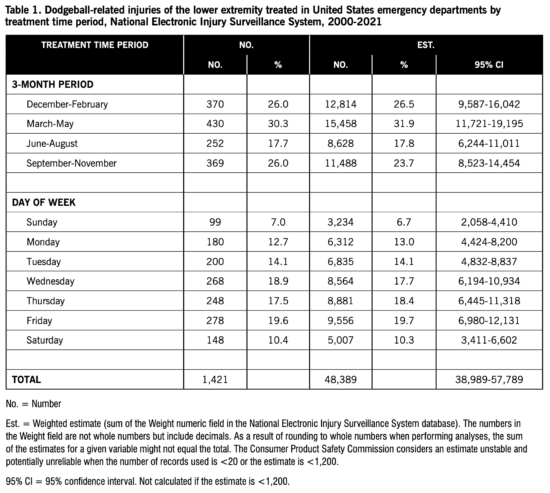 Issues relating to bullying have been raised about playing of dodgeball in schools.1,2 The National Association for Sport and Physical Education (NASPE) issued a position statement in 2006 that dodgeball was not an appropriate activity for K-12 school physical education programs.3 Dodgeball has been banned in some United States (US) school districts.1,4,5
Issues relating to bullying have been raised about playing of dodgeball in schools.1,2 The National Association for Sport and Physical Education (NASPE) issued a position statement in 2006 that dodgeball was not an appropriate activity for K-12 school physical education programs.3 Dodgeball has been banned in some United States (US) school districts.1,4,5
At the same time, dodgeball has become increasingly popular among adults.5 The Sport and Social Industry Association reported in 2014 that adult dodgeball participation had grown 20% annually over the previous 3 years.6 Organized dodgeball is played by tens of thousands of adults in the US.7
Literature on injuries that occur while playing dodgeball is limited.8-11 A study of dodgeball-related injuries treated at hospital emergency departments (EDs) found that an estimated 185,000 such injuries occurred in the US during 2001-2018.12 Approximately 21.4% of dodgeball-related injuries among children and 31.5% of the injuries among adults affected the lower extremity. The intent of this study was to characterize dodgeball-related injuries of the lower extremity reported to US hospital EDs.
Methods
Data for this study were obtained from the National Electronic Injury Surveillance System (NEISS). The NEISS has been described in detail previously.13 Briefly, the NEISS collects data on consumer product-related injuries treated at a representative sample of approximately 100 of the more than 5,000 US hospital EDs. Product-related injuries include illnesses only if a consumer product, sport, or recreational activity is associated with the onset of the illness. National estimates can be calculated from database records according to the sample weight assigned to each case based on the inverse probability of the hospital being selected for the NEISS sample.14,15 Since NEISS data are publicly available and de-identified, the study is exempt from institutional review board approval.
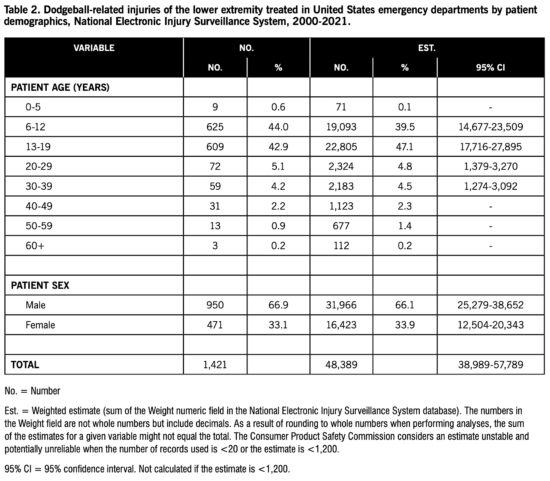 NEISS data for 2000-2021 were downloaded from the NEISS website at (https://www.cpsc.gov/cgibin/NEISSQuery/home.aspx). All records with the letter groups “dod” and “bal” in the Narrative text field were identified and individually searched for those records that appeared to be dodgeball-related injuries. The resulting records that also included the body part code for a lower extremity (upper leg, knee, lower leg, ankle, foot, toe) in either the Body_Part or Body_Part_2 numeric fields were included in the analysis. (It should be noted that the Body_Part_2 field was only added in 2019. Only two records included a body part code for a lower extremity in the Body_Part_2 field but not the Body_Part field.)
NEISS data for 2000-2021 were downloaded from the NEISS website at (https://www.cpsc.gov/cgibin/NEISSQuery/home.aspx). All records with the letter groups “dod” and “bal” in the Narrative text field were identified and individually searched for those records that appeared to be dodgeball-related injuries. The resulting records that also included the body part code for a lower extremity (upper leg, knee, lower leg, ankle, foot, toe) in either the Body_Part or Body_Part_2 numeric fields were included in the analysis. (It should be noted that the Body_Part_2 field was only added in 2019. Only two records included a body part code for a lower extremity in the Body_Part_2 field but not the Body_Part field.)
The variables examined were the treatment date (year, month, day of week), patient age and sex, incident location, patient disposition, diagnosis, and body part affected. The distribution of cases and national injury estimates were determined for the variables. National injury estimates were calculated by summing the values in the Weight numeric field in the publicly available NEISS database, and 95% confidence intervals (CIs) were calculated for the estimates. The Consumer Product Safety Commission (CPSC) considers an estimate unstable and potentially unreliable when the number of records used is <20 or the estimate is <1,200.14 For those variable subgroups where the estimate was <1,200, 95% CIs were not calculated. Analyses were performed using Office Professional 2007 Access and Excel (Microsoft Corporation, Redmond, Washington, US).
Results
A total of 1,421 dodgeball-related injuries of the lower extremity were identified during 2000-2021, resulting in a national estimate of 48,389 (95% CI 38,989-57,789) such injuries. (These represent 22.8% of the total estimated 212,616 dodgeball-related injuries of any body part.) The estimated annual number of injuries increased from 821 during 2000 to 3,233 during 2010, fluctuated between 2,035 and 3,264 during 2011-2019, declined to 800 during 2020, then increased to 1,721 during 2021. Table 1 presents the distribution of dodgeball-related injuries of the lower extremity by three-month period and day of week. The lowest proportion of injuries was during June-August, increasing during each subsequent three-month period to the highest proportion during March-May. The lowest proportions of injuries were treated on Saturday and Sunday.
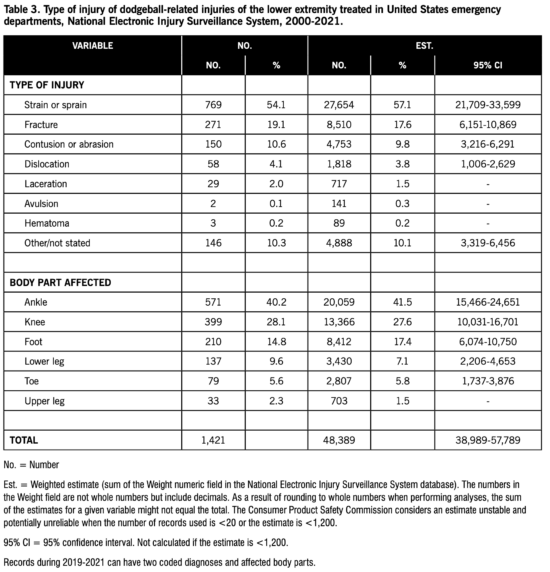 The highest proportion of estimated dodgeball-related injuries involved children age 13-19 years followed by children age 6-12 years; patients age 20 years and older accounted for 12.5% of the injuries (13.3% of the estimated injuries) (Table 2). The majority of patients were male (Table 2).
The highest proportion of estimated dodgeball-related injuries involved children age 13-19 years followed by children age 6-12 years; patients age 20 years and older accounted for 12.5% of the injuries (13.3% of the estimated injuries) (Table 2). The majority of patients were male (Table 2).
Over half of the dodgeball-related injuries of the lower extremity were a strain or sprain with the next most common types of injuries being a fracture and contusion or abrasion (Table 3). The most affected lower extremity body part was the ankle, followed by the knee and foot.
Roughly half of the estimated injuries (51.9%) occurred at school and an additional one-fifth (22.0%) at a place of recreation or sports. Of the estimated injuries, the majority of patients (98.2%) were treated or examined at the hospital ED and released; only 1.5% were admitted for hospitalization.
Discussion
While the estimated annual number of dodgeball-related injuries of the lower extremity increased during 2000-2010, this trend did not continue. It is possible that the number of people playing dodgeball, and subsequently being injured, did not increase after 2010. The number of adults playing dodgeball was reported to have increased at least in the years immediately after 2010.6 However, concerns about whether playing dodgeball was appropriate in schools,1,2 and its banning in some US school districts,1,4,5 may have resulted in a decrease in the number of children playing dodgeball, and thus being injured.
The estimated number of dodgeball-related injuries of the lower extremity was 800 during 2020, a decline of 75% over the estimated number reported during 2019 (n=3,264) and the lowest annual estimate during the entire 22-year time period. This is likely the result of the COVID-19 pandemic, when, during at least the early part of the COVID-19 pandemic in 2020, many schools and other facilities were closed and stay-at-home orders and social distancing were implemented.16 As a result, people, particularly children, had less opportunity to play dodgeball. In 2021, when many of the COVID-19 pandemic restrictions had been relaxed,16 the estimated annual number of dodgeball-related injuries of the lower extremity increased to 1,721. Still, excluding 2020, 2021 had the lowest estimated annual number of injuries since 2004 and was 47% lower than the estimated number of injuries during 2019.
Although not limited to any particular age group, the majority (87%) of injuries involved children age 6-19 years. Since this age group is school age and dodgeball is often played in school, it might be expected that many of the injuries occurred in school. This study found that school was the incident location for the highest proportion of such injuries. Furthermore, only 18% of the injuries were reported during June-August, when most US schools are not in session, and only 17% of the injuries were treated during the weekend.
The most common type of injury was a strain or sprain, accounting for over half of the reported injuries of the lower extremity, followed by a fracture and contusion or abrasion. These types of injuries might be considered relatively minor and not require hospitalization. This study found that 98% of the patients were treated or examined at the hospital ED and released.
There are limitations to this study. Cases were identified by searching for “dod” and “bal” in the Narrative field. Dodgeball-related injuries of the lower extremity where these terms were not documented in the Narrative field would not have been included in this investigation. This study only included those injuries treated at an ED. The number of dodgeball-related injuries of the lower extremity not seen at an ED is unknown. Investigation of such injuries from other data sources might provide a more complete view of these injuries.
In conclusion, the majority of dodgeball-related injuries of the lower extremity occurred among children age 6-19 years. After increasing during 2001-2006, the annual estimated number of injuries remained relatively stable until 2020. The most frequently reported injuries were a strain or sprain followed by fracture and contusion or abrasion. The majority of patients were treated or examined and released from the hospital ED.
Mathias B. Forrester, BS, is an independent researcher in Austin, Texas. Now retired, he previously performed public health research for various university and government programs for 33 years.
- Butler J, Burns DP, Robson C. Dodgeball: Inadvertently teaching oppression in physical health education. Euro Phys Ed Re. 2021;27(1):27-40.
- Reed K. Dodgeball has no place in our schools. Huffington Post May 7, 2014. Available at https://www.huffpost.com/entry/dodgeball-has-no-place-in_b_5281756. Accessed Aug. 1, 2022.
- National Association for Sport and Physical Education. Position on dodgeball in physical education [Position statement]. Reston, VA; 2006. Available at https://peacefulplaygrounds.com/download/pdf/Position-on-Dodgeball-in-PE-2006.pdf. Accessed Aug. 1, 2022.
- Patel A. Experts say dodgeball is ‘legitimized bullying’ – is the game really the problem? Global News June 5, 2019. Available at https://globalnews.ca/news/5355416/dodgeball-bullying-children/. Accessed Aug. 1, 2022.
- Paley AR. All grown up, dodgeball hurtles toward a higher popularity. The Washington Post July 12, 2004. Available at https://www.washingtonpost.com/archive/local/2004/07/12/all-grown-up-dodgeball-hurtles-toward-a-higher-popularity/98b28134-b894-420f-9dc0-023be38e595b/?utm_term=.2851f3e90430. Accessed Aug. 1, 2022.
- Beaton A. Dodgeball’s adults keep eyes on prize money. Wall Street Journal August 7, 2014. Available at https://www.wsj.com/articles/dodgeball-is-for-grown-ups-toowith-prize-money-1407465334. Accessed Aug. 1, 2022.
- LoRe’ M. Dodgeball’s popularity in the United States. September 3, 2018. Available at https://michael-lore.com/2018/09/03/usa-dodgeball/. Accessed Aug.1, 2022.
- Swischuk LE. Musculoskeletal: what is different in children? Playing dodge ball: falls, wrist pain. Emerg Radiol. 2015;22(1):79-81.
- Wang HK, Chen HJ, Lu K, et al. A pediatric chronic subdural hematoma after dodgeball head injury. Pediatr Emerg Care. 2010;26(9):667-668.
- Gornitzky AL, Potty AG, Carey JL, Ganley TJ. Repair of acute-on-chronic subscapularis insufficiency in an adolescent athlete. Orthopedics. 2015;38(9):e844-e848.
- Hsing DD, Madikians A. True-true, unrelated: A case report. Pediatr Emerg Care. 2005;21(11):755-759.
- Forrester MB. Dodgeball-related injuries treated at emergency departments. Am J Emerg Med. 2020;38(3):613-617.
- Forrester MB. Pickleball-related injuries involving the lower extremity treated in emergency departments. Lower Extremity Review. 2021;13(5):24-30.
- United States Consumer Product Safety Commission. National Electronic Injury Surveillance System (NEISS). Available at https://www.cpsc.gov/Research–Statistics/NEISS-Injury-Data/Explanation-Of-NEISS-Estimates-Obtained-Through-The-CPSC-Website. Aug. 1, 2022.
- United States Consumer Product Safety Commission. NEISS Coding Manual. January 2021. Available at https://www.cpsc.gov/s3fs-public/January-2021-NT-CPSC-only-NEISS-Coding-Manual.pdf?xa_nMM1kB4SGpuSMOwf0NHkkkIqNcn8F. Accessed Aug. 1, 2022.
- Muccari R, Chow D, Murphy J. Coronavirus timeline: Tracking the critical moments of Covid-19. NBC News December 29, 2020; updated Jan. 1, 2021. Available at https://www.nbcnews.com/health/health-news/coronavirus-timeline-tracking-critical-moments-covid-19-n1154341. Accessed Aug. 1, 2022.


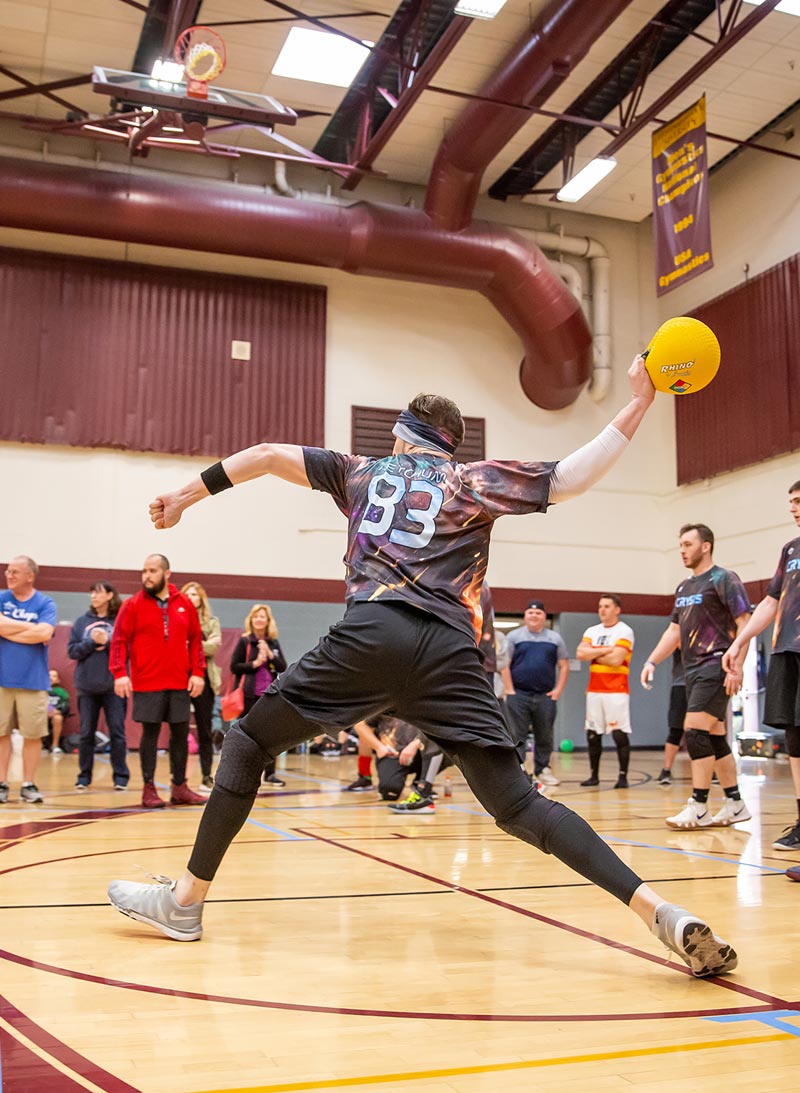
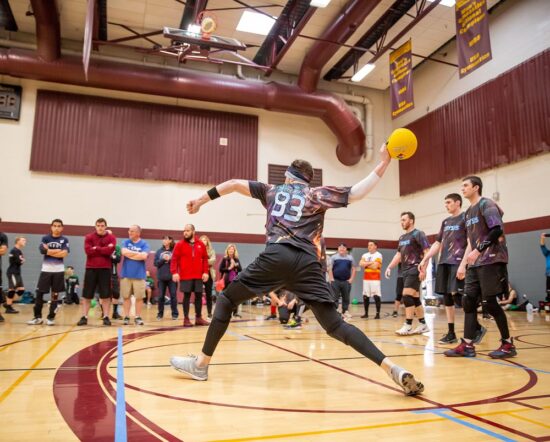





I enjoyed reading your article about dodgeball. I never realized that this was even a sport. I remember the days of playing dodgeball in the school yard. We used to play that only the feet and ankles were fair to hit with the ball. Fun memories.
Guess this is not the dodgeball I played on the school yard as a child. I would assume a lateral ankle injury would be the most common complaint seen in the office. Stress fractures in the foot could also occur.